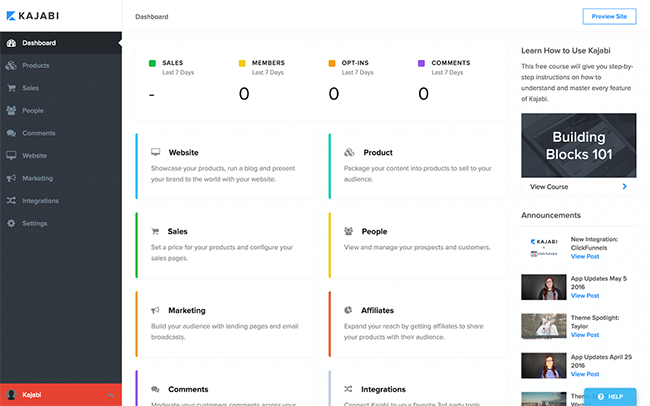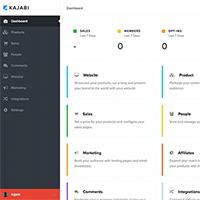Anything’s easy if you only know how. Same goes for building a business centered on online courses – it’s easy when you know how. Which is the point of this article.
Before you can build superior online courses you need to have a roadmap. This roadmap should:
- Start with what you’re going to specialize in
- Display an excellent understanding of who you plan to serve
- Plan your content
- Select the method you’re going to use to deliver your online courses
The reason for doing things in this order is because you have many software options, and without knowing exactly what you want to do and how, you’re setting yourself up for unnecessary frustration and expense.
If there’s one thing to take home from this article, it’s this: Do your homework!
Step 1: What’s Your Speciality?
If you have yet to decide what your online courses will be about, compile a list of what you are good at and what you are passionate about. It’s helpful to use a mind mapping tool like Freemind.
The next thing to do is create a twist in the mix to differentiate your courses from those of your competitors. You may need to do some competitive marketing analysis.
Step 2: Who’s Your Audience?
You will not effectively create or promote any online course without knowing who you are building the course for.
If you are passionate about your subject, you should have a good idea of who your target audience is, but it still pays to do some research. You can use marketing and traffic analysis services such as Alexa to view demographics of related websites to get an idea of the age, location, and education of your target audience.
Step 3: Plan Your Lessons
It is suggested that you plan your lessons around these points:
- Name of the online course – This is an important aspect of the branding of your course
- Brainstorm the “Hook” – This is more important than the actual name of your course as the hook is what will make prospects join your course over your competitors
- What do you want your participants to achieve from your course? – All the other content needs to be based on this core focus.
- Plan the outline of the course – Base this on why they would attend your course in the first place, and the answers they are looking for from joining
- Cater to everybody’s learning style – This means incorporating various methods of presenting your content such as video, text, images, interaction, and so on
Step 4: Which Delivery Method?
For small to medium sized business, there are three delivery methods to choose from:
- Hosted-for-you Learning Management Systems
- Syndication Webites
- WordPress Plugins
A word of warning: you’re going to want to do meticulous homework for this step because once you’ve committed and built your courses with a content delivery method, to change at a later stage is going to make you want to pull your hair out. Slowly.
Why?
Well, if you know the pros and cons of syndication sites, it’s pretty clear cut. It’s the other two methods you need to go into with your eyes wide open. Do not make the mistake of thinking that a syndication site is the easy way to go as there are consequences to that choice too. This is why you will spend a bit more time on this particular section.
Let’s start with Hosted Learning Management Systems. This delivery method is brilliant because you can create your own website and you have marketing tools like landing pages included in the package, allowing you to conduct your business from one dashboard. These platforms provide everything you need to create, manage, sell and promote online courses. You can get set up this option up faster than any other software
Withineach platform are variations. These are important to find out because they can make a huge difference (depending on your business goals).
For instance, take four of the top LMS platforms: Kajabi, Thinkific, Ruzuku and Teachable. They all offer similar features, but only Kajabi and Teachable have blogging features. This is very important if you want your website to rank well in search engine results because search engines depend on content for higher rankings.
Ablogging feature may not be an issue for you if you have your own website with blog content already, but then you need to find out if the Learning Management System (LMS) can integrate with your website so that you can still build traffic from the content of your site.

When you compare prices between systems, make sure you check all the capabilities of the software because what each one offers can save expense and make life easier. For instance, Kajabi is the only LMS to offer autoresponder emails, so this feature saves you that additional expense. Kajabi is the only LMS platform to offer a full-on marketing function too so you can greatly reduce your email marketing costs.
In addition, with an LMS like Kajabi, assuming you add regular blogging content, you’d be assured of getting organic traffic without paying for it via advertising as search engines rank sites with blogging content higher than those without it. The Kajabi software gives you all the tools you need under one roof.
Now let’s look at Syndication Websites. These are marketplaces like SkillShare and Udemy where anyone can present a course online (provided they follow their guidelines).
The benefit of these websites are that they are stable and already receive a lot of traffic. The marketplaces spend money advertising in order to bring more traffic as well.

The downside is that competition is fierce. Your course may be featured at the end of search results so you will not benefit from being listed there. Additionally, when your course is listed there you are forced to participate by their rules. They decide when there will be a sale.
Find out these two elements:
- Is there a work-around so that although your course participants automatically join the syndication site’s email list, you can get their details for your list too? This is vital for up selling and referrals.
- What will you need to do to get on the top of the site’s search results?
Lastly, there is WordPress Plugins.
If you have already built a WordPress website you can either use a hosted LMS platform integrated with your site or membership plugins from within your WordPress website.
There are many to choose from, but again, each one offers slightly different features.
You may need to use an LMS plugin together with a membership plugin for the kind of functionality you will need. The issue with this option is that sometimes certain plugins and themes don’t work well together and have the potential of breaking your site.
This should not be a problem if you (A) Check with the plugin maker that you can get a refund if this happens, and, (B) Perform a backup of your website before installing the plugin (you should be backing up regularly anyways).
Conclusion
Follow a roadmap. Don’t invest in any software until you understand fully what you want to achieve, which includes:
- It goes without saying that you’ll have to know your course objectives, and to stand out, you’ll need to add some kind of twist: something you offer that your competitors don’t
- Know your audience
- Plan lessons around your end objective
- Decide on an online course delivery method after exploring all options
Good luck.
Dvora
:)

